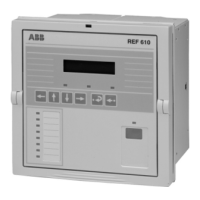Normally, the CBFP controls the upstream circuit breaker. However, it can also be
used for tripping via redundant trip circuits of the same circuit breaker.
5.1.4.7. Arc protection
The arc protection detects arc situations in air insulated metal-clad switchgears,
caused by human error during maintenance or poor contact in the cable connections,
for instance. Local light detection requires the optional arc light detection hardware.
The arc protection can be realized as a stand-alone function in a single REF 610 or
as a station-wide arc protection including several REF 610 protection relays. If
realized as a station-wide arc protection, different tripping schemes can be selected
for the operation of the circuit breakers of the incoming and outgoing feeders.
Consequently, the REF 610 relays in the station can, for instance, be set to trip the
circuit breaker of either the incoming or the outgoing feeder depending on the fault
location in the switchgear. For maximum safety, the REF 610 relays can be set to
always trip both the circuit breaker of the incoming feeder and that of the outgoing
feeder.
The arc protection consists of:
*
Optional arc light detection hardware with automatic backlight compensation for
two lens sensors
*
A light signal output for routing the locally detected light signal to another relay
*
The protection stage ARC with phase- and earth-fault current measurement.
The light from an arc is detected either locally or via a remote light signal. Locally,
the light is detected by lens sensors connected to inputs Light sensor 1 and Light
sensor 2 on the serial communication module of the relay. The lens sensors can be
placed, for instance, in the busbar compartment and the cable compartment of the
metal-clad cubicle.
The light detected by the lens sensors is compared to an automatically adjusted
reference level. Inputs Light sensor 1 and Light sensor 2 have their own reference
levels. When the reference level of either or both inputs is exceeded, an arc has been
detected locally. When light has been detected locally or remotely and one or several
phase currents exceed the set current limit ArcI>, or the earth-fault current the set
current limit ArcI
0
>, the arc protection stage (ARC) will generate a trip signal in less
than 15 ms. The stage will be reset in 30 ms after all three phase currents and the
earth-fault current have fallen below the set current limits.
The light signal output, L>, can be configured to be activated either immediately
upon detection of light in all situations, or only when the arc has not been
extinguished by the time the trip signal is generated. The selection is made in SGF4.
By routing the light signal output to an output contact connected to a digital input of
another REF 610 relay, a station-wide arc protection is realized.
stage ARC and the light signal output can be set out of operation in SGF3.
Inputs not in use should be covered with dust caps.
34
REF 610REF 610
Feeder Protection Relay
Technical Reference Manual
1MRS755310

